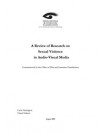The Classification Office commissioned researchers from Victoria University to conduct a literature review focusing on research conducted in the 1990s or later. The review grouped together studies that used similar methods, commenting on methodological strengths and weaknesses as well as reporting on the findings. The aim of this review was to draw out common themes and to highlight trends and gaps in the literature.
Key Results
Content analysis, main findings:
- Sexual violence themes have become more prevalent in mainstream media.
- Rape myths regularly appear in mainstream media dealing with sexual violence themes.
- A significant proportion of sexually explicit material includes sexual violence.
- Video and internet material includes much more sexual violence than print media.
- The internet hosts a lot of extremely sexually explicit violent material; however, little research has been done on this.
- Sexually violent material is more likely to involve black and brown-skinned models and actors than white models and actors. Conversely, sexually explicit material involving white models and actors is more likely to show mutually consensual and pleasurable sex.
Discourse analysis, main findings:
- Ostensibly anti-rape stories in mainstream media may be presented so as to provoke prurient interest.
- Many representations of rape in film and television support rape myths.
- Film and TV storylines often show rape as a catalyst and justification for heroic (usually male) violence.
- Anti-rape activists praise storylines that show female solidarity and community organisation rather than violence as a solution to the problem of rape.
- Anti-rape activists praise storylines that confront rape myths and highlight problems with the justice system from the survivor’s point of view.
- Some anti-rape activists think that even questionable representations of sexual violence provide good opportunities for public discussion.
- Analysts of extremely sexually explicit and violent Japanese manga worry about the violence toward homosexual men in this material.
Sexually Violent Media: Audience Opinion and Effects
Audience opinion, main findings:
- People think sexually violent material will not harm them, but they worry about how it will affect others.
- Most people did not think that the availability of sexually violent material would affect rates of sexual violence.
- Images of sexual violence are more controversial than images of just sex or just violence.
- There may be considerable differences in definitions of what counts as sexual violence among the public.
- Audiences often disagreed with official censorship interpretations of the messages particular films sent about sexual violence.
- Dangerous sexual activity such as asphyxiation should not be shown because people might imitate it and hurt themselves or someone else.
- Sexually violent material which presents the violent sexual activity as consensual and pleasurable could harm people in real life if the type of violence appears intense enough to cause serious physical injury or death.
Perpetrators and victims, main findings:
- A significant proportion of sexual violence victims report being forced to view, imitate or participate in producing sexually explicit or sexually violent material, or that their abuser used such material.
- Rapists consume no more sexually explicit or sexually violent material than the general population.
- Child sex abusers report early exposure to sexually explicit and sexually violent material, usually as part of a sexualised childhood.
Audience studies, main findings:
- Women who watch a lot of TV or have been exposed to pornography early in life are more likely to accept rape myths.
- Men who enjoy sexually violent material are more likely to report having engaged in sexually aggressive behaviour in the past and report more possibility of doing so in the future.
Experimental studies, main findings:
- Experiments suffer from attrition problems: people who are really offended or upset by sexually violent material will not participate.
- Behavioural experiments have serious problems with internal validity because the experiment requires participants to act aggressively.
- Under experimental conditions participants exposed to images of sexual violence against women consistently display more aggression toward women.
- Two separate experiments produced some support for the desensitisation hypothesis: male and female viewers repeatedly exposed to sexually violent material reacted to it with less criticism, anxiety or depression over time.
- Two separate experiments supported the hypothesis that viewing sexually violent material would make viewers less sympathetic to complainants of rape in the courtroom.
- Social cues matter in how people interpret somewhat ambiguous sexually violent and sexually explicit material.
Correlational research, main findings:
- These studies do not distinguish between sexually explicit and sexually violent material and so have limited use for our purposes.
- These studies take sexual violence rates reported to police as their measure of sexual violence, further limiting their relevance.
- These studies have mixed findings.
Directions for further research, main findings:
- More research is needed about people who participate in online sexually violent fantasy activity.
- The internet blurs the distinction between representation and performance, raising new questions about media effects and requiring innovative research methods.
- Future research should investigate aspects of sexually violent representations available on new media such as mobile phones and digital games.
- Another area where research is lacking is on representations of sexual violence against homosexual men.
- Finally, future research should investigate whether sexual violence is prevalent in texts introduced into New Zealand by diasporic groups, and whether there is a large New Zealand audience for non-Western sexually violent material, such as some Japanese manga.

